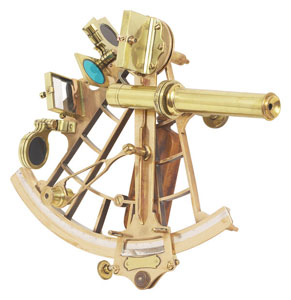While it has been widely reported that the U.S. Naval Academy is restoring celestial navigation to its curriculum, the truth is that the Academy is moving “slow astern” from its 2006 decision to drop celestial.
The Academy, based in Annapolis, Md., resumed classroom instruction for midshipmen during the 2015 summer session — but only up to a point. According to campus spokeswoman Judy Campbell, a survey of the discipline — what an Annapolis press release calls “celestial familiarization”—has been introduced for third-year students as a three-hour segment of a much broader advanced navigation course that concentrates on GPS, radar, tides and currents, piloting, bridge simulations and voyage planning.
What the syllabus does not do is teach the core workload of celestial navigators: sextant sight reductions of sun, moon, stars and planets. The academy’s press release describes the new offering largely as a series of PowerPoint presentations along with homework and tests based on material from the 15th edition of Dutton’s Nautical Navigation.
“Midshipmen are given an overview of what celestial navigation is,” Campbell said. “They learn theory — concepts of celestial navigation — but they do not learn to use the sextant.”
She noted, however, that sextant navigation continued to be part of “a more intensive course of study” for the officer-candidate crew of Annapolis’ 44-foot training yacht Defiance (Capt. Midshipman Jared Valeske), which finished second in its class in last year’s Marion-Bermuda race. The Annapolis press release pointed out that the yacht’s “varsity offshore sailing team” had employed the campus planetarium “for exposure to [the] stars and constellations they would be able to shoot to celestially navigate.”
In November 2013, I wrote in this space that the Naval Academy had consigned the sextant to a dustbin of maritime relics as quaint as the knotted log-line. But without the sextant, I had added, there obviously could be no celestial navigation. The Navy’s then-current standard of navigation, an academy official told me at the time, stipulated that “encrypted GPS is the primary fix source in open ocean waters.”
The official also said that abandoning the sextant and related studies had been part of a shift in emphasis “in response to changes in Navy requirements.” The official identified those demands as centering on “practical instruction in the use of” electronic software programs.
In restoring to the curriculum at least an overview of celestial navigation, the Naval Academy affirms that the discipline is one of the techniques “still relevant to safe operations at sea.” But this is as far as Annapolis seems willing to go. Celestial navigation, though labeled an “enduring requirement,” remains a stepchild, not much more than what the academy calls an “administrative change.”
 |
By contrast, the Navy’s Surface Warfare School at Newport, R.I., has taken a different tack. Here, 26 hours of classroom work and sextant practice for commissioned officers cover the full spectrum of celestial navigation study: definition and uses of time, sight reductions of observations, plotting lines of position, the celestial fix, the noon sight, azimuths and amplitudes of the sun.
Lt. Cmdr. Katherine Meadows, public affairs officer for the Naval Education and Training Command, Pensacola, Fla., acknowledges that the Navy in 2006 “removed celestial navigation as a core [seagoing] competency and [also as] part of our training” in favor of a basket of high-tech electronic solutions to offshore position finding. In 2011, she said, celestial training was restored for officer navigators and assistant navigators of surface warships.
Although the Navy does not say so directly, there seems little doubt that the decision to revive instruction in celestial navigation stems from growing concerns over the vulnerability of electronic navigational systems to breakdowns and cyberattacks. The Massachusetts Maritime Academy, Buzzards Bay, for example, is explicit in arguing for celestial capability “as a second check [on electronics] and as a backup navigational system … in time of need.”
Meadows, in discussing the scope of celestial education either in place or contemplated by her command, went on to say that three collegiate ROTC units have begun pilot survey courses similar in content to the new curriculum at Annapolis.
Meadows said the Navy would assess the programs at the end of the school year with a view to extending even limited celestial instruction to ROTC units elsewhere in the country.
She also said planning was now underway for the Navy’s quartermaster (non-commissioned officer) schools, at Newport and at Great Lakes, Ill., to offer advanced training in celestial navigation, including use of the sextant. “We are currently building the curriculum,” she said. “We expect it to be ready in 2016.”
She added: “We continuously look at our requirements for training and improvements for Fleet readiness.” The ability to navigate by sun and stars, she said, “is an important skill for our mariners.”

